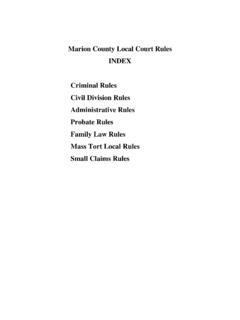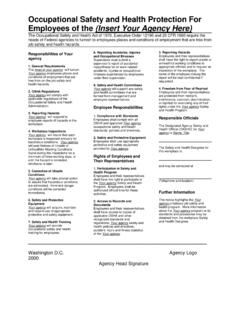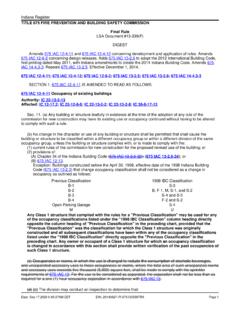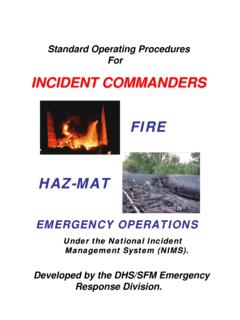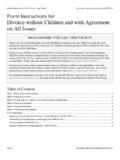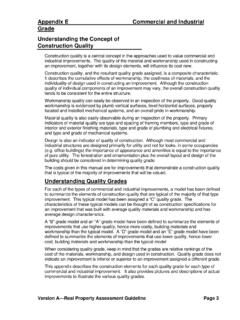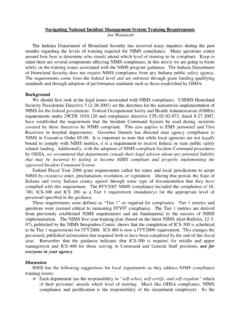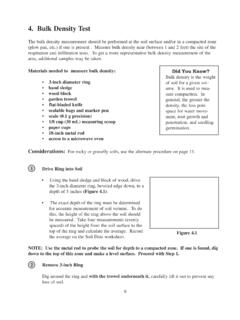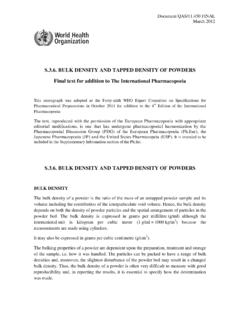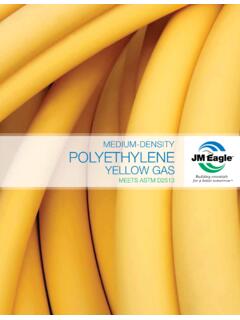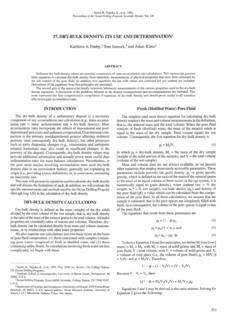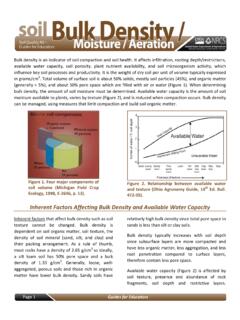Transcription of 11 Soils Field Procedures Using the Sand Cone Method - …
1 11 Soils Field Procedures Using the Sand Cone Method Apparatus Cone Correction and bulk density Factors Procedure 11-1 CHAPTER ELEVEN: Soils Field Procedures Using THE SAND CONE Method Field density determination of soil compaction is done in accordance with AASHTO T 191 (Sand Cone) or AASHTO T 310 (Nuclear Gauge). This chapter discusses the Procedures for Using AASHTO T 191. AASHTO T 191 contains three very distinct and important sections.
2 These are: 1) Section 3: Apparatus 2) Section 4: Cone Correction and bulk density Factors 3) Section 5: Procedure The following references are required to be reviewed for this chapter: Standard Specifications 1) Section (b) AASHTO 1) T 191 - density of Soil In-Place by the Sand-Cone Method 2) T 224 - Correction for Coarse Particles in the Soil Compaction Test 3) T 255 - Total Evaporable Moisture Content of Aggregate by Drying ITM 1) 506 - Field Determination of Moisture Content of Soils 11-2 APPARATUS The apparatus (Figure 11-1) required for the Sand Cone Method consists of a one-gallon jar, a detachable metal appliance, and a base plate.
3 The metal appliance is attached to the jar to allow the sand to flow from the jar during calibrations or density testing. The density apparatus and base plate are detailed in AASHTO T 191 Section 3. A calibration container is also required for this test. The calibration container is used to determine the sand density . The requirements for this container are also detailed in AASHTO T 191 Section 3. The volume of the container is determined annually at the District Testing lab in accordance with AASHTO T 19.
4 The volume of the container is marked on the side of the container to an accuracy of ft3. Figure 11-1. Base Plate, Apparatus, and Calibration Container 11-3 CONE CORRECTION AND bulk density FACTORS Prior to determining the bulk density of the sand and conducting density tests, the Technician determines the weight of sand required to fill the large cone of the density apparatus and the accompanying base plate.
5 This weight is determined to the nearest pounds and is referred to as the Cone Correction. The density apparatus and the base plate are required to remain together and not be interchanged with other devices without recalculating the Cone Correction. The Cone Correction is calculated daily on Form IT 625 (for soil) and on Form TD 320 (granular material). The procedure for determination of the Cone Correction is detailed in AASHTO T 191 and is summarized as follows: 1) Fill the apparatus with the calibration sand and record the weight to the nearest lb 2) Place the base plate on a clean, level surface 3) Invert the apparatus onto the base plate and open the valve to allow the cone and the base plate to fill with sand 4) When the sand stops flowing into the cone, shut the valve and weigh the apparatus to the nearest lb 5) The difference between the full weight of the apparatus and the final weight after filling the cone is referred to as the Cone Correction.
6 Determination of the bulk density of the calibration sand is a procedure done daily by the Technician prior to conducting in-place density tests. The bulk density of the calibration sand is referred to as the sand calibration factor. The gradation of the calibration sand required for this test is required to be in accordance with Section (b), which is an exception to AASHTO T 191. Sand complying with this requirement is furnished by District Testing and is obtained with the density equipment.
7 The determination of the calibration sand density is done in accordance with AASHTO T 191 and recorded on Form IT 625, Daily Summary of Soil In-Place density Tests or on Form TD 320, Daily Summary of In-Place density Tests (+3/4 material). The determination of the bulk density of the calibration sand is done daily and when a new bag of sand is used. 11-4 A calibration container with a known volume is required to determine the bulk density of the calibration sand.
8 By knowing the volume of the calibration container and the weight of calibration sand required to fill the container, the bulk density of the calibration sand in pounds per cubic foot may be calculated. The process of determining the bulk density of the sand is detailed in AASHTO T191 Section 4 and is summarized as follows: 1) Fill the apparatus with the calibration sand and record the weight to the nearest lb 2) Place the base plate on the calibration container 3) Invert the apparatus on the base plate and open the valve to allow the calibration container and the large cone to fill with sand 4)
9 Shut the valve on the apparatus and weigh the apparatus to the nearest lb The initial weight of the apparatus minus the final weight and minus the Cone Correction is the weight of the calibration sand required to fill the container. Divide the weight of the sand in the container by the volume of the container to determine the bulk density of the sand. The bulk density of the sand is calculated to the nearest lb/ft3. Sections through detail the methods of embankment construction with density control and without density control.
10 The Frequency Manual lists the frequency of tests on embankment construction. Embankment layers so granular that density testing is impractical may be controlled visually and documented as such on Form IT 625 or Form TD 320. Documentation of visually accepted lifts of embankment maintains a record of the Method of acceptance of the lift for coordination with the frequency manual requirements. PROCEDURE With the calculations of the bulk density of the calibration sand and the Cone Correction Factor completed, the Technician has all of the information necessary to begin in-place density tests.

